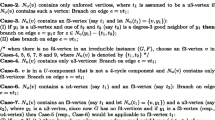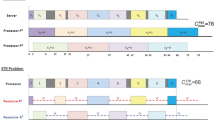Abstract
In the precedence-constrained traveling salesman problem (PTSP) we are given a partial order on n nodes, each of which is labeled by one of k points in a metric space. We are to find a visit order consistent with the precedence constraints that minimizes the total cost of the corresponding path in the metric space. We give negative results on approximability by relating the problem to the Shortest Common Supersequence problem, helping to explain why there has been very little success in approximation algorithms for this problem. We also give approximation algorithms for a number of special cases, included cases appropriate for a problem in low-power computing; in the process, we show that algorithms for the k-server problem and the traveling salesman problem can be used to derive approximation algorithms for the PTSP. We give tight bounds on the approximation ratios achieved by natural classes of algorithms for this optimization problem (which include algorithms proposed and used in empirical studies of this problem). We briefly summarize results of experiments with several algorithms on a standard set of compiler benchmarks, comparing several known and new algorithms.
Supported by Stanford School of Engineering Groswith Fellowship, an ARO MURI Grant DAAH04-96-1-0007 and NSF Award CCR-9357849, with matching funds from IBM, Schlumberger Foundation, Shell Foundation, and Xerox Corporation.
Supported by an Alfred P. Sloan Research Fellowship, an IBM Faculty Partnership Award, an ARO MURI Grant DAAH04-96-1-0007, and NSF Young Investigator Award CCR-9357849, with matching funds from IBM, Mitsubishi, Schlumberger Foundation, Shell Foundation, and Xerox Corporation.
Supported by the Department of Defense, with partial support from ARO MURI Grant DAAH04-96-1-0007 and NSF Award CCR-9357849, with matching funds from IBM, Schlumberger Foundation, Shell Foundation, and Xerox Corporation.
Preview
Unable to display preview. Download preview PDF.
Similar content being viewed by others
References
A. Aggarwal, A.K. Chandra and P. Raghavan. Energy Consumption in VLSI Circuits. In Proceedings of the ACM Symposium on Theory of Computing, 1988, pp. 205–216.
R. Bhatia, S. Khuller, and J. Naor. The Loading Time Scheduling Problem. In Proceedings of the 36th Annual IEEE Symposium on Foundations of Computer Science, 1995, pp. 72–81.
L. Bianco, A. Mingozzi, S. Riccardelli, and M. Spadoni. Exact and Heuristic Procedures for the Traveling Salesman Problem with Precedence Constraints, Based on Dynamic Programming. INFOR, 32(1):19–32, 1994.
N. Christofides. Vehicle Routing. In The Traveling Salesman Problem: A Guided Tour of Combinatorial Optimization (Ed: E.L. Lawler, J.K. Lenstra, A.H.G. Rinnooy Kan, and D.B. Shmoys), John Wiley & Sons (1985), pp. 431–448.
C.J. Colbourn and W.R. Pulleyblank. Minimizing Setups in Ordered Sets of Fixed Width. Order, 1:225–229 (1985).
S. Devadas and S. Malik. A Survey of Optimization Techniques Targeting Low-Power VLSI Circuits. Preprint, 1995.
M. Garey and D. Johnson. Computers and Intractability — a Guide to the Theory of NP-completeness. W.H. Freeman, San Francisco, 1979.
B.L. Golden and A.A. Assad, Eds. Vehicle Routing. Methods and Studies. North-Holland, Amsterdam (1988).
K. Govil, E. Chan, and H. Wasserman. Comparing Algorithms for Dynamic Speed-Setting of a Low-Power CPU. Preprint, 1995.
T. Jiang and M. Li. On the Approximation of Shortest Common Supersequences and Longest Common Subsequences. In Proceedings of 21st International Colloquium on Automata, Languages and Programming, 1994, pp. 191–202.
G. Kissin. Energy Consumption in VLSI Circuits: a Foundation. ACM Symposium on Theory of Computing, 1982.
M. Kubo and H. Kagusai. Heuristic Algorithms for the Single-Vehicle Dial-a-ride Problem. Journal of the Operations Research Society of Japan, 30(4):354–365, 1990.
M. T Lee, V. Tiwari, S. Malik, and M. Fujita. Power Analysis and Low-Power Scheduling Techniques for Embedded DSP Software. Technical Report FLA-CAD-95-O1, Fujitsu Labs of America, March 1996.
M. Manasse, L. McGeoch, and D. Sleator. Competitive Algorithms for Server Problems. Journal of Algorithms, 11:208–230 (1990).
R. Motwani, K. Palem, S. Reyen, and V Sarkar. Combining Register Allocation and Instruction Scheduling. Submitted for publication, 1997. Preliminary version: Technical Report STAN-CS-TN-95-22, Department of Computer Science, Stanford University, 1996.
S. Prasad and K. Roy. Circuit Activity Driven Multilevel Logic Optimization for Low Power Reliable Operation. Proceedings of the European Conference on Design Autoamtion (EDAC), 1993, pp. 368–372.
K. Roy and S. Prasad. SYSLOP: Synthesis of CMOS Logic for Low-Power Applications. In Proceedings of the International Conference on Computer Design, 1992.
SPEC Consortium. The SPECint95 and SPECfp95 Benchmarks. World-Wide Web URL http://www.specbench.org, 1995.
C-L. Su, C-Y Tsui, and A.M. Despain. Low-Power Architecture Design and Compilation Techniques for High-Performance Processors. In Proceedings of the IEEE COMPCON, 1994, pp. 489–498.
V. Tiwari, S. Malik, and A. Wolfe. Power analysis of embedded software: A first step towards software power minimization. IEEE Transaction on VLSI Systems, 2:437–445 (1994).
V. Tiwari, S. Malik, and A. Wolfe. Compilation Techniques for Low Energy: An Overview. In Proceedings of the 1994 Symposium on Low-Power Electronics, 1994, pp. 38–39.
C.Y. Tsui, M. Pedram, and A.M. Despain. Technology Decomposition and Mapping Targeting Low-Power Dissipation. In Proceedings of the 30th Design Automation Conference, 1993, pp. 68–73.
M. Weiser. Some Computer Science Issues in Ubiquitous Computing. Communications of the ACM, 36:74–83 (1993).
F. Yao, A. Demers, and S. Shenker. A Scheduling Model for Reduced CPU Energy. In Proceedings of the 36th Annual IEEE Symposium on Foundations of Computer Science, 1995, pp. 374–382.
Author information
Authors and Affiliations
Editor information
Rights and permissions
Copyright information
© 1997 Springer-Verlag Berlin Heidelberg
About this paper
Cite this paper
Charikar, M., Motwani, R., Raghavan, P., Silverstein, C. (1997). Constrained TSP and low-power computing. In: Dehne, F., Rau-Chaplin, A., Sack, JR., Tamassia, R. (eds) Algorithms and Data Structures. WADS 1997. Lecture Notes in Computer Science, vol 1272. Springer, Berlin, Heidelberg. https://doi.org/10.1007/3-540-63307-3_51
Download citation
DOI: https://doi.org/10.1007/3-540-63307-3_51
Published:
Publisher Name: Springer, Berlin, Heidelberg
Print ISBN: 978-3-540-63307-5
Online ISBN: 978-3-540-69422-9
eBook Packages: Springer Book Archive




